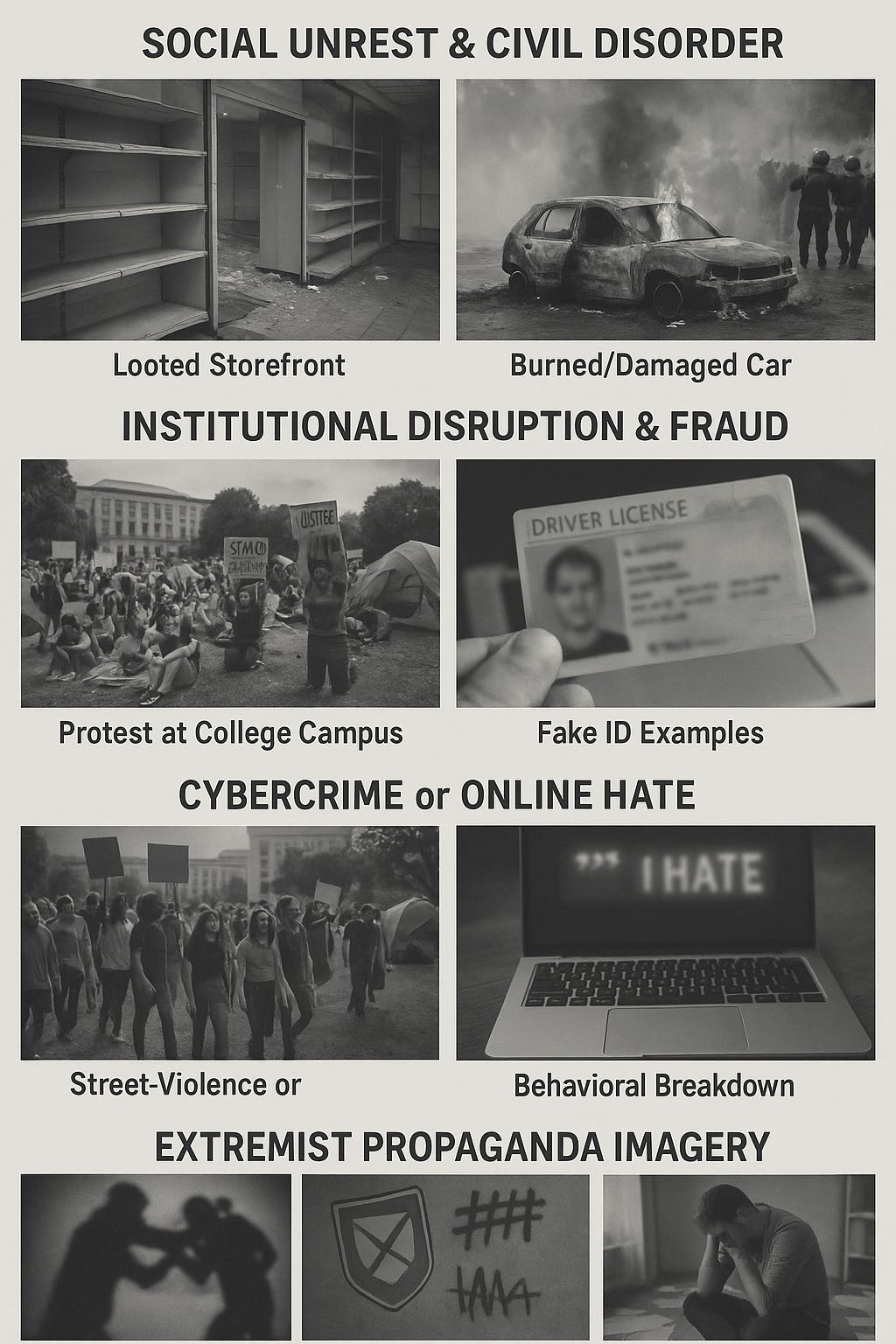When Society Snaps:
What 2025’s Criminal Chaos Reveals About Identity, Ideology, and Unchecked Trauma
America in 2025: Unraveling at the Seams or Exposing the Fractures?
Across cities, campuses, and courtrooms, 2025 feels less like civil unrest and more like a systemic psychological rupture. Pharmacies are looted in daylight. Teslas are targeted and torched in ideological tantrums. Predators hide behind gender identity shields. And college campuses—once havens of debate—now cheer for terror groups and intimidate Jewish students into silence.
This isn’t random. It’s not just politics. It’s behavioral collapse in plain sight.
The question isn’t why is this happening—it’s what is this chaos revealing about who we’ve become?
The Rise in “Moral Justification” Crimes
2025 has seen a significant spike in crimes that aren’t committed in secret—but celebrated publicly:
Lootings of Walgreens, Walmart, and independent retailers in Chicago, Los Angeles, Philadelphia, and Oakland continue in organized waves
"Anticapitalist" vandalism of Teslas and other “symbols of privilege” has been shared on social media with applause, not shame
Campus protests supporting Hamas or “intifada” rhetoric have blocked access, torn down flags, and physically intimidated students—especially Jews
Police ambushes and execution-style killings of officers now occur weekly, often during routine calls or traffic stops
These aren't isolated. They’re tied to tribal identity narratives that justify destruction as activism.
Psychology of the Crowd: From Protest to Mob
According to Gustave Le Bon’s classic theory and reinforced by modern forensic research, groupthink lowers moral restraint. In 2025, we’re watching mass moral disengagement—a process where individuals detach from empathy and ethical judgment once their actions are seen as part of a “just cause.”
The Journal of Aggression and Violent Behavior (2021) confirmed that ideologically driven violence increases when:
The individual believes the system is rigged
There’s emotional contagion through social platforms
The group offers identity protection (i.e., “We’re all in this together”)
In other words: it’s not the crime—it’s the justification system behind it that fuels replication.
Identity as Armor: The Rise of False Self-Shields
Not all identity claims are authentic. And 2025 has exposed a disturbing trend: predators claiming marginalized identities to avoid scrutiny or gain access.
A DOJ task force in March 2025 found that 9% of prosecuted child sex crimes involved offenders claiming a transgender or nonbinary identity—whether authentic or weaponized
Some cases involved biological males entering female shelters or restrooms under false identity declarations, later arrested for assault
Law enforcement in multiple states has flagged a “groomer loophole,” where gender identity shields are used to avoid vetting for volunteer roles or youth access
To be clear: transgender people as a group are not the problem. But predators exploiting identity protections is an emerging forensic pattern—and denying that only enables future abuse.
Campus Radicalization: Weaponizing Victimhood
The rhetoric on American college campuses in 2025 has shifted from activism to outright extremism. What began as opposition to foreign wars has metastasized into:
Open support for terror groups like Hamas, under the guise of liberation
Silencing dissent through intimidation, doxxing, and physical threats
Antisemitism masked as anti-Zionism, often escalating into violence
A 2025 survey by the Foundation for Individual Rights and Expression (FIRE) found that:
72% of Jewish college students feel unsafe expressing their views
48% of students believe violence is justifiable if a speaker is labeled “hateful”
Nearly half of protestors couldn’t name basic facts about the conflicts they’re protesting
This isn’t education—it’s psychological manipulation via tribal enmeshment.
The Data Doesn't Lie: Crime Is Up—And Shifting in Nature
2025 FBI and DOJ crime data reflect the evolution of violence:
Retail thefts up 38% in major metro areas
Group violence incidents (3+ offenders) up 41%
Police ambushes up 29% compared to 2022
Religious hate crimes, particularly antisemitic incidents, have doubled in universities
Gender-based legal loophole abuse now flagged in 12 states
This isn’t political spin. It’s behavioral data.
Root Causes: The Unhealed Wound
So what’s driving it all?
Intergenerational trauma—passed down, unprocessed, and amplified
Social media trauma loops—constant exposure to rage, humiliation, and disinformation
Algorithmic outrage amplification—platforms reward divisiveness
Weak consequences—criminals are emboldened by prosecutors who won’t prosecute
Identity obsession—where people derive worth not from values, but labels
As a forensic mental health professional, I’ve seen this before—in prison populations, cult survivors, and radicalized groups. Now we’re watching it bleed into mainstream culture.
What Can Be Done?
Solutions require more than slogans. We need:
Behavioral analysis in justice systems—prosecutors must consider the psychology of ideology
Early intervention programs for youth showing signs of sadistic, extremist, or enmeshed thinking
Accountability for false identity use, especially in cases involving vulnerable populations
Digital ethics mandates—social platforms must be held liable for rage-driven design
Restoration of consequence culture—without accountability, pathology spreads
Closing Thoughts
The collapse we’re witnessing isn’t random—it’s cumulative.
The symptoms—violence, looting, terror-glorifying protests—are all expressions of unprocessed pain, tribal rage, and behavioral disorders dressed in moral language.
And unless society starts addressing the roots—not just the riots—we’ll continue to treat destruction as a side effect, instead of what it really is: a collective cry for meaning without morality.
Dr. Mozelle Martin is a forensic handwriting expert, retired clinical director, and international law enforcement consultant with 38 years of investigative experience. Her work centers on ethics, forensic analysis, and animal advocacy across behavioral science, digital defamation, and applied psychology.





